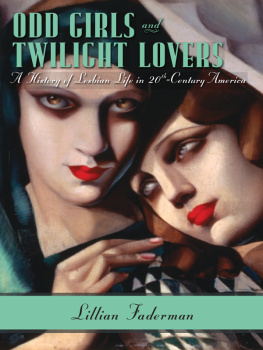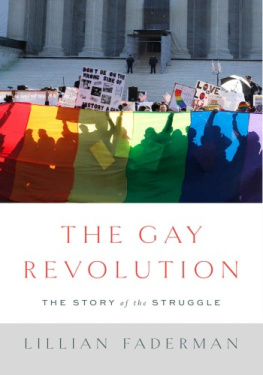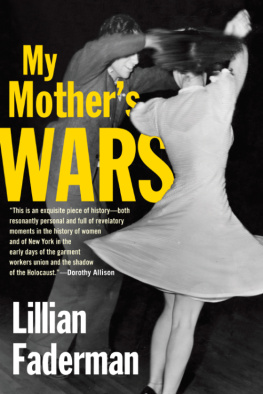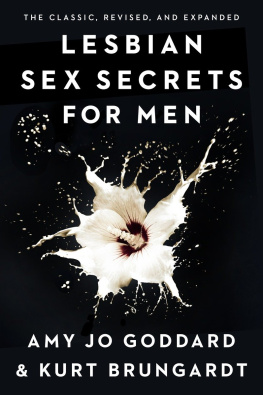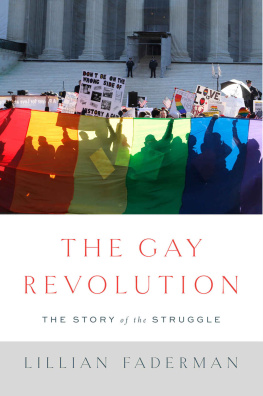ODD GIRLS AND TWILIGHT LOVERS
Between Men ~ Between Women
Lesbian and Gay Studies
LILLIAN FADERMAN
Columbia University Press
New York
Columbia University Press
New York Oxford
cup.columbia.edu
Copyright 1991 Lillian Faderman
Paperback edition, 2012
All rights reserved
E-ISBN 978-0-231-53074-3
Library of Congress Cataloging-in-Publication Data
Faderman, Lillian.
Odd girls and twilight lovers: a history of lesbian life in twentieth-century America / Lillian Faderman.
p. cm.(Between menbetween women)
ISBN 978-0-231-07488-9 (cloth : alk. paper) ISBN 978-0-231-07489-6 (pbk.: alk. paper)
1. LesbianismUnited StatesHistory20th centtury. 2. LesbiansUnited StatesHistory20th centtury. I. Title. II. Series.
HQ75.6.U5F33 1991
9026327
306.76630973dc20
CIP
Casebound editions of Columbia University Press books are Smyth-sewn and printed on permanent and durable acid-free paper.
A Columbia University Press E-book.
CUP would be pleased to hear about your reading experience with this e-book at .
Between Men ~ Between Women
Lesbian, Gay, and Bisexual Studies
Terry Castle and Larry Gross, Editors
ADVISORY BOARD OF EDITORS
Claudia Card
John DEmilio
Esther Newton
Anne Peplau
Eugene Rice
Kendall Thomas
Jeffrey Weeks
Between Men ~ Between Women is a forum for current lesbian and gay scholarship in the humanities and social sciences. The series includes both books that rest within specific traditional disciplines and are substantially about gay men, bisexuals, or lesbians and books that are interdisciplinary in ways that reveal new insights into gay, bisexual, or lesbian experience, transform traditional disciplinary methods in consequence of the perspectives that experience provides, or begin to establish lesbian and gay studies as a freestanding inquiry Established to contribute to an increased understanding of lesbians, bisexuals, and gay men, the series also aims to provide through that understanding a wider comprehension of culture in general.
Contents
Acknowledgments
A book of this nature could not be written without the generous help of many people and institutions. For assigned time to pursue my research and writing, I wish to thank the English Department at California State University, Fresno, and the former dean of the School of Arts and Humanities, Dr. Joseph Satin. For opening their doors to me, even at hours not always convenient to them, I am grateful to the staff of the Blanche Baker Memorial Library of the One Institute, the June L. Mazer Lesbian Collection in Los Angeles and the New York Lesbian Herstory Archives. My special thanks go to Degania Golove and Joan Nestle. For invaluable photographic and computer assistance I am grateful to Phyllis Irwin and Avrom Faderman. For arranging numerous interviews for me and often providing transportation and lodging and always support and encouragement, I thank Clare Freeman, Tracy Rappaport, and Peg Cruikshank in San Francisco; Sonia and Allison in New York; Olivia Sawyers, JoAnn, Margaret, and Ann in San Antonio; the women of Bookwoman and Dede in Austin; Sharon Young, Suzanne Valery, and River Malcom in San Diego; Alice and Jacki in Los Angeles; Mary Ann and Dena in Carson City; Sari Dworkin and Nancy in Fresno; Judy Carlson in Kansas City; Marsha Pelham and Tomi in Boston; Joy Letta Alice of Commonwoman Bookstore, and Kathleen Wingard in Lincoln, Nebraska; and Muriel Rada and Rhonda in Omaha. For their wonderful support when I needed it most, I thank my agent Sandra Dijkstra and my editor at Columbia University Press, Ann Miller. I am especially grateful to the women across the country who were willing to talk to me about their lives and gave me so many hours of their time.
In 1843 the American author William Cullen Bryant wrote an essay for the Evening Post in which he glowingly described a trip to Vermont, where, among natures beauties, he had the opportunity to observe a beautiful female friendship between two revered maiden ladies. Bryant was not alone in his boundless admiration for the pair and the peaceful and loving relationship they established together, as he said when he gave their history:
In their youthful days, they took each other as companions for life, and this union, no less sacred to them than the tie of marriage, has subsisted, in uninterrupted harmony, for 40 years, during which they have shared each others occupations and pleasures and works of charity while in health, and watched over each other tenderly in sickness. They slept on the same pillow and had a common purse, and adopted each others relations, and I would tell you of their dwelling, encircled with roses, and I would speak of the friendly attentions which their neighbors, people of kind hearts and simple manners, seem to take pleasure in bestowing upon them.
If such a description of love between two women had been published in an American newpaper a century later, surely the editors desk would have been piled high with correspondence about immorality in Vermont (slept on the same pillow!) and the two women in question would have felt constrained to sue Bryant for defamation of character in order to clear their good names. In 1843, however, the two ladies were flattered and the newspapers readers were charmed.
What is apparent through this example and hundreds of others that have now been well documented by social historians is that womens intimate relationships were universally encouraged in centuries outside of our own. There were, of course, some limitations placed on those relationships as far as society was concerned. For instance, if an eligible male came along, the women were not to feel that they could send him on his way in favor of their romantic friendship; they were not to hope that they could find gainful employment to support such a same-sex love relationship permanently or that they could usurp any other male privileges in support of that relationship; and they were not to intimate in any way that an erotic element might possibly exist in their love for each other. Outside of those strictures, female same-sex loveor romantic friendship, as it was long calledwas a respected social institution in America.
What went on in secret between two women who were passionately attached to each other, as William Cullen Bryants friends were, is naturally more difficult to reconstruct than their contemporaries attitude toward what they thought they were seeing. There were few women before our era who would have committed confessions regarding erotic exchanges to writing. Trial records indicate that females of the lower classes who were vulnerable to harassment by the criminal courts sometimes had sexual relations with each other, but there is no comparable record in America for respectable women. One might speculate that since they generally lived in a culture that sought to deny the possiblitity of womens autonomous sexuality, many of them cultivated their own asexuality, and while they might have kissed and hugged on the same pillow, their intimate relations never crossed the boundary to the genitally sexual. But surely for some of them kissing and hugging led eventually to other things and their ways of loving each other were no different from what the twentieth century would describe with certainty as lesbian.

